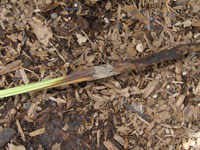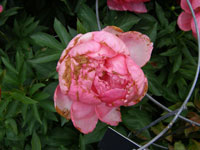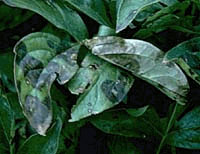Extension > Garden > Diagnose a problem > What's wrong with my plant? > Annuals and Perennials > Peony > Plant wilts
Peony > Whole Plant > Plant wilts
1 of 3
Gray Mold
Botrytis paeoniae
- New shoots turn black, wilt and die when they emerge in the spring
- Leaves and petals have black to brown irregular spots, and may turn completely black
- Stem infections turn brown or black and often have a target spot appearance
- Flower buds turn black to brown and fail to open
- All infected plant parts produce fluffy gray spores with moisture
- Most common in cool, wet weather
- More information on Gray Mold
2 of 3
Phytophora Leaf Blight
Phytophora cactorum
- Black leathery spots on leaves or buds
- New shoots or stems have long sunken black lesions and may fall over
- In severe cases the crown and roots of the plant are soft, wet and mulchy; the entire plant wilts and dies
- Common in heavy, poorly drained soil
- Most severe in wet weather
- Confirmed cases should be removed and destroyed, together with adjacent soil.
- Planting healthy clumps in new locations where the soil is well drained usually prevents further trouble.
3 of 8
- - NO PHOTO AVAILABLE -
Verticillium Wilt
Verticillium albo-atrum
- Leaves and shoots wilt
- No signs of discoloration or rot on the outside of stems
- Brown to tan discoloration of water conducting tissue in cut end of stem
- Symptoms commonly seen during bloom period
- More information on Verticillium Wilt







